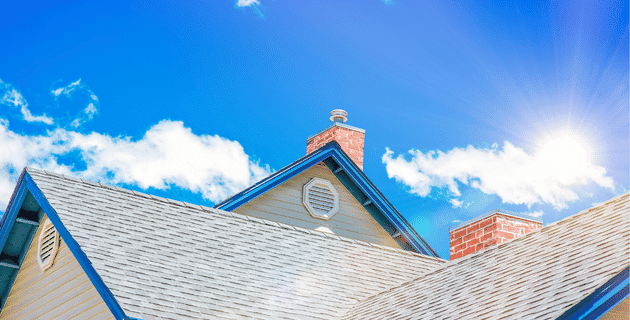Who doesn’t love a sunny day? …But when those beautiful rays shine down on your home, you might not love what happens; from faded furniture to deteriorating roof shingles, the sun’s ultraviolet (UV) rays can cause quite a bit of damage over time.
UV rays happen even on a cloudy day, and just as we wear sunscreen to protect our skin, we need to take action to protect our homes.
Here’s what you can do.
Use window shades.
Regular window glass only blocks a portion of those damaging UV rays. Using window shades can help. Invest in solar shades designed to block UV rays and still let in light. These shades are rated by percentage in terms of how much light they block. A 1% shade has a tighter weave and blocks 99% of UV rays. By contrast, a 14% shade blocks just 86%.
Apply window films.
Whether or not you use window shades, you can protect your home from light with window films. These translucent vinyl or polyester strips will cling to window glass, and chances are you won’t even notice them. Plus, they can block 99 percent of UV rays! You can get them professionally installed or do it yourself (DIY). Just know that over time, these films might become scratched or damaged and will need to be replaced.
Replace your window screens.
You may have window screens that are there to prevent bugs from entering your home. Replace them with ones that also block or filter harmful UV rays. That way, if you open a window, the screen is there as a barrier.
Install tinted windows.
A more expensive option is to replace your window glass with low emissivity (low-e) glass. This type of glass protects against UV rays due to its special coating. It also helps insulate your home so your rooms stay warmer in winter and cooler in summer.
Rearrange your furniture. Cover your floors.
A little redecorating can help to protect your furniture and floors. If your couch is in the direct path of sunlight from the window, consider moving it to a shadier spot. Try a slipcover, which can be more easily replaced than a couch when it fades. Similarly, you can cover sunny spots on the floor with area rugs and replace them as needed.
Choose the right fabrics and colors.
Lighter colors show the effects of fading less than darker ones, especially on those outdoor furniture cushions. Some fabrics also wear better. When choosing furniture or fabrics for your home, look for synthetic blends. Nylon and polyester will fade more slowly than cotton.
Spray your furniture and treat your floors.
Hardwood is very sensitive to sunlight but may be treated with stains and finishes that have UV protection. For furniture, consider UV protection sprays. Reapply every 6 months or so. If you have leather furniture, you can apply a leather conditioner to help prevent fading and cracking. You can treat your furniture and floors even after fading begins. It won’t take the fading away but it will help slow the process for the future.
Protect your artwork.
Artwork and photos also can fade over time. Canvases may be treated with UV protection sprays. For framed art, replace the glass with UV-blocking acrylic or the pricier museum-grade glass.
Protect your siding.
Older house siding can actually melt or warp when windows from your neighbor’s home focus sunlight on a small portion of your home’s siding. Protect against this by planting trees and shrubs, which also add more shade to your landscape. You can also buy products that put a coating on your siding to help protect it. If you’re ready to redo your siding, choose one that reflects harmful UV rays away from your home. Not only will it help prevent fading, but it will also keep your home cooler.
Repaint with UV-resistant products.
The paint or stain on your deck, front door, and shutters can fade over time. Repaint using a product that helps resist UV exposure. Check with your local home improvement or hardware store for options.
Treat your roof.
The sun’s rays beat down on your roof, causing shingles to deteriorate. Over time, UV rays dry out the natural oils in your asphalt shingles, and can even crack or weaken the roof underneath. To protect against this, there are special coatings that you can apply. Get a professional to do it if you’re not comfortable working on your roof. The coating will create a waterproof barrier to reflect light, draw heat away and keep the surface cooler. Such coatings generally last about 10 years.
Your home is your greatest investment. Review the impact UV rays are making as part of your regular summer home maintenance. Protect your home with the right homeowner’s insurance, and you’ll continue to enjoy it for years to come.
This article is furnished by California Casualty, providing auto and home insurance to educators, law enforcement officers, firefighters, and nurses. Get a quote at 1.866.704.8614 or www.calcas.com.
- Graduation – When to Remove Your Child from Your Auto Policy - May 18, 2023
- How to Prevent Catalytic Converter Theft - May 17, 2023
- How Much Does Home Insurance Cost? - May 17, 2023

